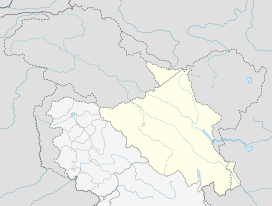Hanu, Ladakh
Hanu (also called Hanoo) is a village panchayat in the Leh district of Ladakh, India.[1] It consists of two villages, Yogma Hanu (Lower Hanu) and Goma Hanu (Upper Hanu), a few miles to the north, in the Hanu valley below the Chorbat La pass. The villages form part of the Khalsi tehsil.
Hanu | |
|---|---|
Village | |
 Hanu Location in Ladakh, India | |
| Coordinates: 34.591°N 76.623°E | |
| Country | India |
| Union Territory | Ladakh |
| District | Leh |
| Tehsil | Khalsi |
| Population (2011) | |
| • Total | 1,207 |
| Time zone | UTC+5:30 (IST) |
| Census code | 940 |
Geography
The two villages Yogma Hanu and Goma Hanu lie in the Hanu valley, which runs between the Chorbat La pass and the Indus River valley near Dah. The Hanu mountain stream flows down the valley jointing the Indus. To the north of the Chorbat La pass, the Chorbat Lungpa river flows north to join the Shyok river near Hassanabad Chorbat. The Chorbat La pass is considered the traditional boundary between Baltistan and Ladakh. According to geographer Frederick Drew, the valleys of Chorbat Lungpa and Hanu constituted the main route from Baltistan to Ladakh in the past. The two villages Goma Hanu and Yogma Hanu are fortified, indicating that they experienced raids from Baltistan in the past.[2]
Demographics
According to the 2011 census of India, Hanoo has 224 households. The effective literacy rate (i.e. the literacy rate of population excluding children aged 6 and below) is 47.69%.[3]
| Total | Male | Female | |
|---|---|---|---|
| Population | 1207 | 587 | 620 |
| Children aged below 6 years | 190 | 95 | 95 |
| Scheduled caste | 1 | 1 | 0 |
| Scheduled tribe | 1204 | 584 | 620 |
| Literates | 485 | 241 | 244 |
| Workers (all) | 638 | 318 | 320 |
| Main workers (total) | 314 | 293 | 21 |
| Main workers: Cultivators | 178 | 173 | 5 |
| Main workers: Agricultural labourers | 1 | 1 | 0 |
| Main workers: Household industry workers | 0 | 0 | 0 |
| Main workers: Other | 135 | 119 | 16 |
| Marginal workers (total) | 324 | 25 | 299 |
| Marginal workers: Cultivators | 317 | 22 | 295 |
| Marginal workers: Agricultural labourers | 1 | 0 | 1 |
| Marginal workers: Household industry workers | 0 | 0 | 0 |
| Marginal workers: Others | 6 | 3 | 3 |
| Non-workers | 569 | 269 | 300 |
References
- "Blockwise Village Amenity Directory" (PDF). Ladakh Autonomous Hill Development Council 2014–15. Archived from the original (PDF) on 3 April 2018.
- Drew, The Jummoo and Kashmir Territories (1875), pp. 263–264: "The Chorbat Pass is the boundary of Baltistan in this direction; by this road also used to come Balti raiders, as the remains of a fort at Yogma Hanū prove, which the people of the valley had put up against them."
- "Leh district census". 2011 Census of India. Directorate of Census Operations. Retrieved 23 July 2015.
- Sources
- Drew, Frederic (1875), The Jummoo and Kashmir Territories: A Geographical Account, E. Stanford – via archive.org